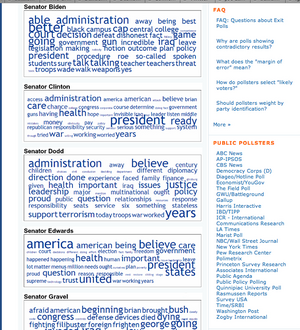For those in the enterprise IA / UX space, The next frontier in IT strategy: A McKinsey Survey centered on the idea that “…IT strategy is maturing from a reactive to a proactive stance”is worth a look.
This nicely parallels a point made about the reactive mindset common to IT in many large organizations, in discussion on the IAI mailing list last month. Lou Rosenfeld’s post Information architects on communicating to IT managers, summarizes the original discussion in the IAI thread, and is worth reading as a companion piece.
Lou’s summary of information architecture and user experience voices in the enterprise arena is noteworthy for including many examples of strong correspondence between McKinsey’s understanding of how IT strategy will mature (a traditional management consulting view), and the collected IA / UX viewpoints on addressing IT leadership – typical buyers for enterprise anything – and innovation.
Dialogs that show convergence of understanding like this serve as positive signs for the future. At present, a large set of deeply rooted cultural assumptions (at their best inaccurate, usually reductive, sometimes even damaging) about the roles of IT, business, and design combine with the historical legacies of corporate structures to needlessly limit what’s possible for User Experience and IA in the enterprise landscape. In practical terms, I’m thinking of those limitations as barriers to the strategy table; constraining who can talk to who, and about which important topics, such as how to spend money, and where the business should go.
Considering the gulf that separated UX and IT viewpoints ten – or even five – years ago, this kind of emerging common understanding is a good sign that the cultural obstacles to a holistic view of the modern enterprise are waning. We know that a holistic view will rely on deep understanding of the user experience aspects of business at all levels to support innovation in products and services. I’m hoping the rest of the players come to understand this soon.
Another good sign is that CIO’s have won a seat at the strategy table, after consistent effort:
Further evidence of IT’s collaborative role in shaping business strategy is the fact that so many CIOs now have a seat at the table with senior management. They report to the CEO in 44 percent of all cases; an additional 42 percent report to either the chief operating officer or the chief financial officer.
Looking ahead, information architecture and user experience viewpoints and practitioners should work toward a similar growth path. We fill a critical and missing strategic role that other traditional viewpoints are not as well positioned to supply.
Quoting McKinsey again:
IT strategy in most companies has not yet reached its full potential, which in our experience involves exploiting innovation to drive constant improvement in the operations of a business and to give it a real advantage over competitors with new products and capabilities. Fewer than two-thirds of the survey respondents say that technological innovation shapes their strategy. Only 43 percent say they are either very or extremely effective at identifying areas where IT can add the most value.
User Experience can and should have a leading voice in setting the agenda for innovation, and shaping understandings of where IT and other groups can add the most value in the enterprise. To this end, I’ll quote Peter Merholz (with apologies for not asking in advance):
“…we’ve reached a point where we’ve maximized efficiency until we can’t maximize no more, and that in order to realize new top-line value, we need to innovate… And right now, innovations are coming from engaging with the experiences people want to have and satisfying *that*.”
McKinsey isn’t making the connection between strategic user experience perspectives and innovation – at least not yet. That’s most likely a consequence of the fact that management consulting firms base their own ways of thinking, organizational models, and product offerings (services, intellectual property, etc.) on addressing buyers who are themselves deeply entrenched in traditional corporate structures and worldviews. And in those worlds, everything is far from miscellaneous, as a glance at the category options available demonstrates; your menu here includes Corporate Finance, Information Technology, Marketing, Operations, Strategy…
BTW: if you weren’t convinced already, this should demonstrate the value of the $40 IAI annual membership fee, or of simply reading Bloug, which is free, over paying for subscriptions to management journals 
